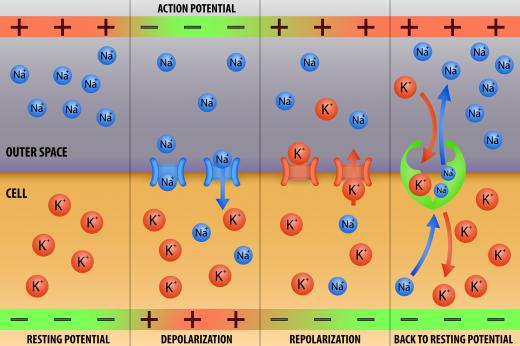What Is Depolarization?
Nerve cells have a negative electrical charge across their plasma membranes, known as the resting potential. The plasma membrane is a thin boundary layer that encloses the nerve cell, and the resting potential exists because the inside of the cell is negatively charged compared with the outside. When a neurotransmitter, a chemical that carries signals between nerve cells, arrives at the membrane, or the membrane is disturbed mechanically, the charge across the membrane changes, becoming more positive. This change is known as depolarization and, if it reaches a certain level, what is called an action potential results, where an electrical impulse is transmitted along the nerve. Following an action potential, the membrane is repolarized, becoming negatively charged again and restoring the resting potential.
The resting potential of nerve cell membranes is created by unequal concentrations of positively charged sodium ions and potassium ions on each side of the membrane. There is more potassium inside the cell and more sodium outside the cell. The reason for this is a sodium-potassium pump situated in the cell membrane, which actively moves sodium out of the cell and potassium into the cell.

There are channels in the membrane through which sodium and potassium ions can travel, but when the membrane is at rest the sodium channels are shut and only some of the potassium channels are open. Sodium ions are forced to remain outside the cell, while some potassium ions escape from the cell to join them through the open channels. The net result is that more positively charged ions end up outside the cell than inside, and this creates the negative charge across the membrane, known as the resting potential, which is necessary if neuron depolarization is to occur.
For an action potential to take place, first the nerve cell has to be stimulated by being stretched or by the arrival of a neurotransmitter. A depolarizing effect then occurs because sodium channels open up and allow sodium into the cell, increasing the number of positively charged ions inside and making the electrical potential across the membrane more positive. Once depolarization reaches a threshold level many sodium channels open at once and an action potential occurs, where complete membrane depolarization suddenly takes place, with depolarization also passing along the nerve cell in a wave.
Following depolarization, repolarization occurs after a brief interval known as the refractory period. During that period any further stimulus applied to the cell has no effect. The refractory period lasts for only a fraction of a second, allowing a nerve to fire many times in the space of one second. Repolarization involves potassium ions moving out of the cell first, before sodium is actively pumped out. Once the membrane potential has reached the necessary negative charge, the resting potential is achieved and the nerve is ready to fire again.
AS FEATURED ON:
AS FEATURED ON:











Discuss this Article
Post your comments